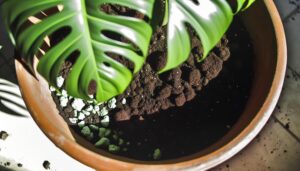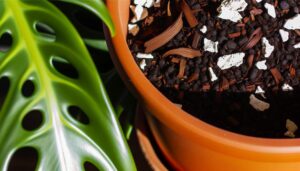Monstera Adansonii New Leaves Black: Causes and Fixes!
If your Monstera Adansonii’s new leaves are turning black, it’s typically due to environmental stressors. Overwatering can cause root rot, while underwatering leads to dehydration.
Check soil moisture and make sure your pot has drainage holes. Improper humidity is another common issue; maintain levels between 60-80% using a hygrometer.
Nutrient deficiencies, especially in nitrogen, phosphorus, and potassium, can also result in black leaves. Finally, consider the possibility of direct sunlight or pest infestations.
By addressing these factors watering practices, humidity control, nutrient supplementation, light conditions you can improve your plant’s health and prevent further leaf blackening. There’s more to discover for ensuring optimal care.
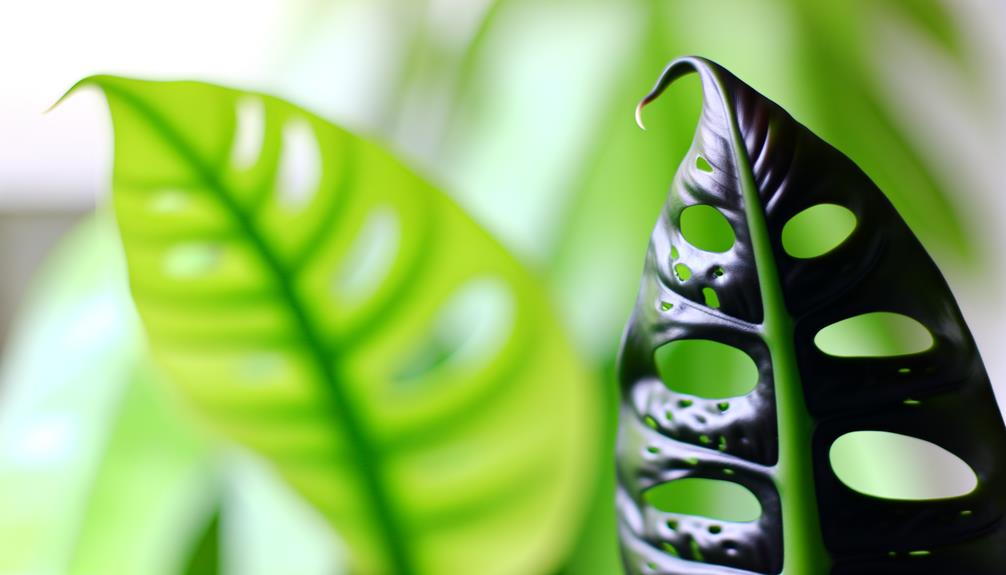
Key Takeaways
- Overwatering can cause root rot, leading to blackening of new Monstera Adansonii leaves.
- Direct sunlight can burn Monstera Adansonii leaves, causing them to turn black.
- Inconsistent humidity levels can stress the plant, resulting in blackened leaves.
- Nutrient deficiencies, particularly in nitrogen and potassium, can cause new leaves to blacken.
- Pest infestations, such as spider mites or aphids, can damage new leaves, leading to black spots or edges.
Common Causes of Black Leaves

Several factors can lead to black leaves on your Monstera adansonii, often related to environmental stressors and improper care practices. Overwatering is a primary culprit, causing root rot, which disrupts nutrient and oxygen uptake. Make sure you’re allowing the soil to dry out between waterings.
Conversely, underwatering stresses the plant, leading to dehydration and leaf discoloration. Inconsistent humidity levels can also affect leaf health; Monstera adansonii thrives in high humidity environments.
Nutrient deficiencies, particularly in nitrogen, phosphorus, and potassium, result in weakened plant structure and compromised leaf integrity. Additionally, exposure to direct sunlight can cause leaf burn, manifesting as blackened patches.
Ensuring proper light, water, and nutrient conditions can prevent these issues and maintain healthy foliage.
Identifying Environmental Stressors
To identify environmental stressors affecting your Monstera Adansonii, closely monitor temperature and humidity levels, as these plants thrive in specific climatic conditions.
Maintain ideal watering and drainage practices, as improper hydration can lead to root rot and subsequent blackening of leaves.
Temperature and Humidity Levels
Accurate monitoring of temperature and humidity levels is essential, as deviations from the ideal range can induce significant environmental stressors in Monstera Adansonii, leading to blackening of new leaves.
You should maintain the following conditions to ensure best growth:
- Temperature: Keep ambient temperatures between 65-80°F (18-27°C). Avoid sudden temperature fluctuations, which can shock the plant.
- Humidity: Maintain relative humidity levels of 60-80%. Low humidity can cause leaf desiccation, while excessively high humidity may promote fungal growth.
- Ventilation: Provide adequate air circulation to prevent stagnant air, which can exacerbate temperature and humidity issues.
Watering and Drainage Practices
Consistently monitoring and adjusting your watering and drainage practices is crucial for preventing blackening of new Monstera Adansonii leaves. Overwatering can lead to root rot, causing oxygen deprivation and subsequent leaf necrosis. Guarantee the potting medium is well-draining and includes components like perlite and orchid bark to facilitate aeration. Conversely, underwatering stresses the plant, hindering nutrient uptake and leading to leaf blackening.
| Watering Frequency | Soil Composition | Drainage System |
|---|---|---|
| Every 1-2 weeks | 50% potting soil, 25% perlite, 25% orchid bark | Pots with drainage holes |
| Check moisture level | Avoid waterlogged conditions | Use a humidity tray |
| Use filtered water | Maintain pH 5.5-7.0 | Elevate pots with feet |
Regularly assess soil moisture and adjust practices accordingly to sustain plant health.
Watering Issues and Solutions
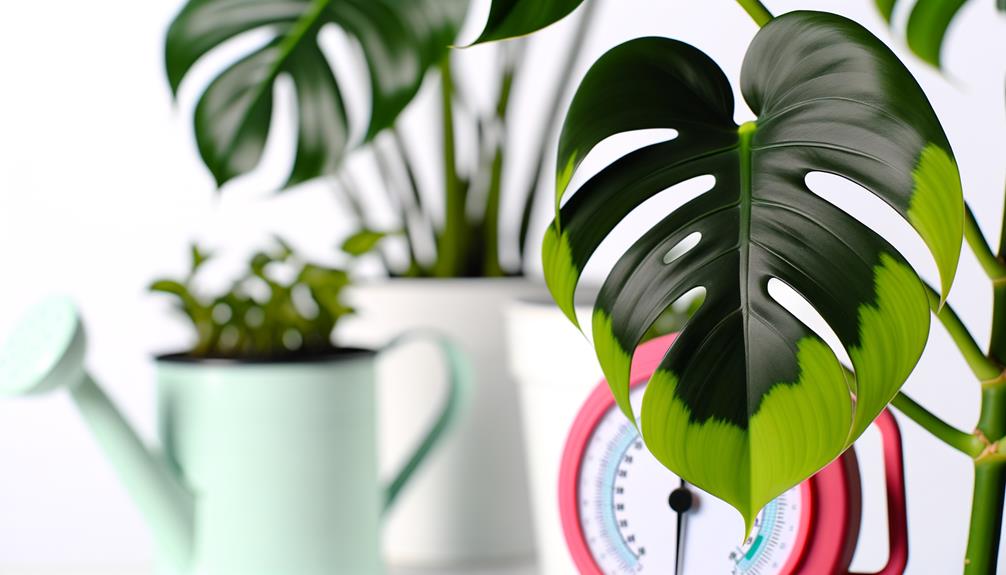
Overwatering your Monstera adansonii can result in root rot, which often manifests as blackened new leaves. To prevent this, you need to adjust your watering practices.
Soil Moisture: Check the soil moisture before watering. Use a moisture meter or insert your finger 2 inches deep. If it’s dry, then water.
Drainage: Confirm your pot has adequate drainage holes. This prevents water from pooling and causing root suffocation.
Watering Schedule: Establish a consistent watering schedule. Monstera adansonii prefers slightly moist soil but hates being waterlogged. Typically, once a week is sufficient, but adjust based on environmental conditions.
Importance of Humidity Levels
In addition to proper watering, maintaining the right humidity levels is essential for preventing blackened leaves in your Monstera adansonii. This tropical plant thrives in environments with relative humidity between 60-80%. When humidity drops below this range, transpiration rates increase, causing leaf desiccation and subsequent blackening.
Utilize a hygrometer to monitor ambient humidity accurately. If levels are insufficient, deploy a humidifier or place a water-filled pebble tray beneath the plant. Mist the leaves regularly, but avoid over-saturation to prevent fungal infections.
Also, group plants together to create a microenvironment with increased humidity. By ensuring ideal humidity, you’ll bolster your Monstera adansonii’s physiological processes, promoting healthy growth and mitigating leaf blackening.
Nutrient Imbalances
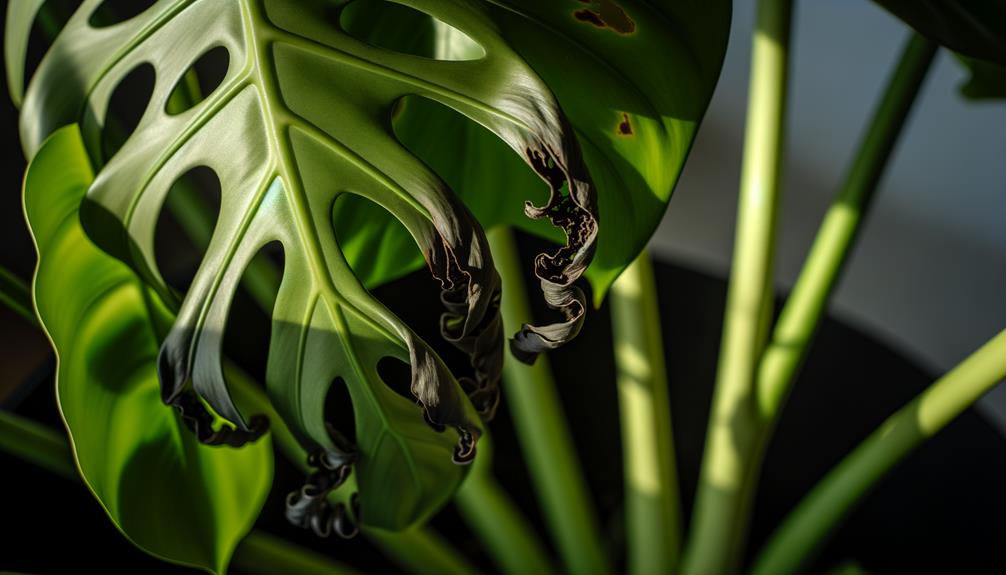
Nutrient imbalances, particularly deficiencies in essential minerals like nitrogen, phosphorus, and potassium, can lead to blackened leaves in your Monstera adansonii. These macronutrients are important for various physiological processes.
For example, nitrogen is necessary for chlorophyll production, which drives photosynthesis. Phosphorus supports root development and energy transfer, while potassium regulates water uptake and enzyme activation.
To diagnose and correct nutrient deficiencies, consider the following steps:
- Soil Testing: Analyze the soil to identify nutrient levels and deficiencies.
- Fertilization: Use a balanced, water-soluble fertilizer to guarantee a steady supply of essential nutrients.
- Monitoring: Regularly observe new growth for any signs of discoloration or deformity.
Pest and Disease Management
You must first identify common pests like spider mites, aphids, and mealybugs, which can cause significant damage to Monstera Adansonii.
Look for disease symptoms such as chlorosis, necrosis, and wilting, which indicate fungal or bacterial infections.
Utilize effective treatment methods including insecticidal soaps, neem oil, and fungicides to manage these issues and promote healthy plant growth.
Common Pests Identification
Identifying common pests, such as spider mites, aphids, and thrips, is essential for effective pest and disease management in Monstera adansonii plants. You need to know the specific signs of each pest to take appropriate action.
- Spider Mites: Look for fine webbing on the undersides of leaves and tiny, moving specks. These arachnids cause stippling and yellowing of foliage.
- Aphids: Detect these small, pear-shaped insects by their clusters on new growth. They excrete honeydew, leading to sooty mold.
- Thrips: Identify these slender, winged insects by their black fecal spots and silvery streaks on leaves. They puncture plant cells to feed, causing distortion and discoloration.
Monitoring your plant regularly helps in early detection and effective control.
Disease Symptoms Recognition
How can you accurately recognize disease symptoms in Monstera adansonii to guarantee prompt and effective management?
Begin by observing the foliage. Black lesions on new leaves can indicate fungal infections such as Septoria or Alternaria.
Look for chlorosis, where leaves turn yellow due to insufficient chlorophyll.
Examine the undersides of leaves for powdery mildew, characterized by a white, powdery residue.
Root rot, caused by pathogens like Pythium or Phytophthora, manifests as blackened, mushy roots and wilting foliage.
Bacterial blight, evidenced by water-soaked lesions that turn necrotic, can also affect Monstera adansonii.
Regularly inspect for signs of stress, such as leaf curl or stunted growth, which may suggest underlying disease issues.
Accurate recognition helps in timely intervention.
Effective Treatment Methods
Implementing integrated pest management (IPM) strategies effectively controls both pests and diseases in Monstera adansonii, ensuring robust plant health. Begin by identifying the specific pest or pathogen affecting your plant. Use biological control agents such as predatory insects or neem oil to manage infestations naturally. Chemical treatments should be a last resort due to potential phytotoxicity.
To manage diseases, follow these steps:
- Sanitation: Remove and dispose of affected leaves to prevent pathogen spread.
- Fungicides: Apply appropriate fungicides, such as copper-based solutions, to manage fungal infections.
- Environmental Control: Adjust humidity and light conditions to create an inhospitable environment for pathogens.
Steps for Reviving Your Plant
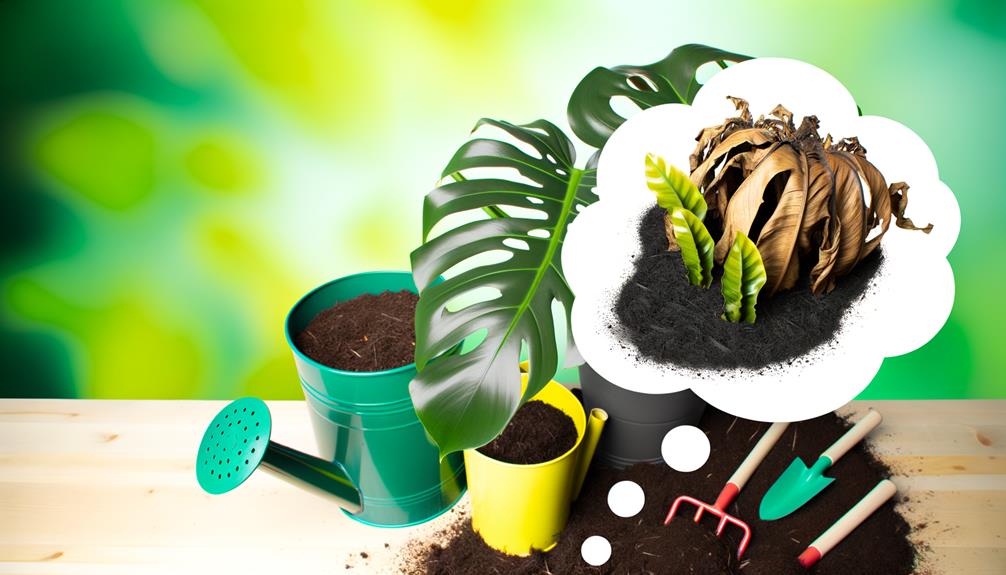
To revive your Monstera Adansonii, first make certain that it’s receiving proper light conditions, ideally bright but indirect sunlight, to prevent further leaf blackening.
Inspect the root system for signs of root rot, such as mushy, discolored roots. Prune any affected roots using sterilized scissors.
Make sure that the potting medium is well-draining to avoid waterlogged conditions. Adjust your watering schedule; the soil should be moist but not soggy.
Monitor ambient humidity levels, aiming for 60-70% to mimic the plant’s natural habitat.
Apply a balanced, diluted fertilizer bi-monthly to provide essential nutrients.
Lastly, check for pests like spider mites or aphids, and treat using an appropriate insecticidal soap or neem oil.
Black Spots On Monstera Adansonii
Black spots on Monstera adansonii can be caused by several factors:
- Overwatering: Excess water can lead to root rot, which manifests as black spots on the leaves. Ensure proper drainage and let the soil dry out between waterings.
- Underwatering: Prolonged drought stress can also cause black spots. Water the plant when the top inch of soil feels dry.
- Pests: Insects like spider mites or thrips can damage leaves, leading to black spots. Inspect the plant and treat with insecticidal soap if necessary.
- Fungal or Bacterial Infection: Pathogens can cause leaf spots. Remove affected leaves, improve air circulation, and consider using a fungicide.
- Low Humidity: Monstera adansonii prefers high humidity. Increase humidity around the plant using a humidifier or a pebble tray.
Addressing the underlying cause promptly will help restore your plant’s health.
Conclusion
To conclude, understanding why your Monstera adansonii’s new leaves are turning black requires a multifaceted approach. You’ve got to address environmental stressors, fine-tune watering practices, achieve ideal humidity levels, and correct nutrient imbalances.
Don’t forget to manage pests and diseases meticulously. By following these steps, you’ll breathe life back into your plant, like a skilled conductor orchestrating a symphony of best conditions. Your Monstera will thrive in no time.

